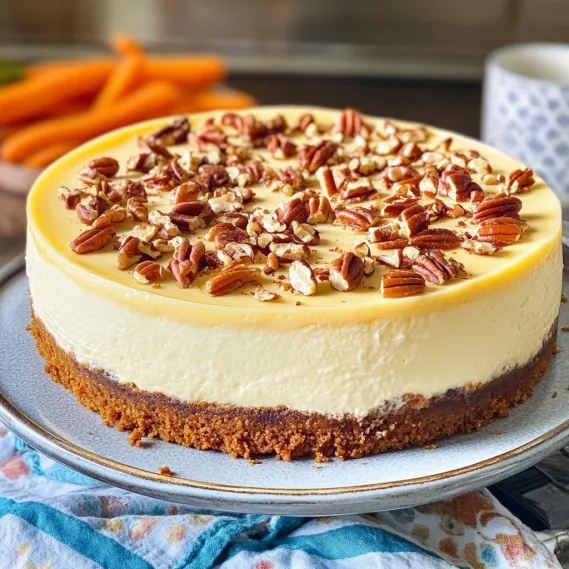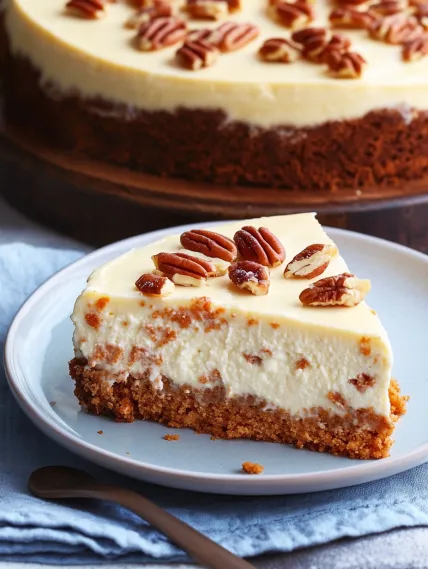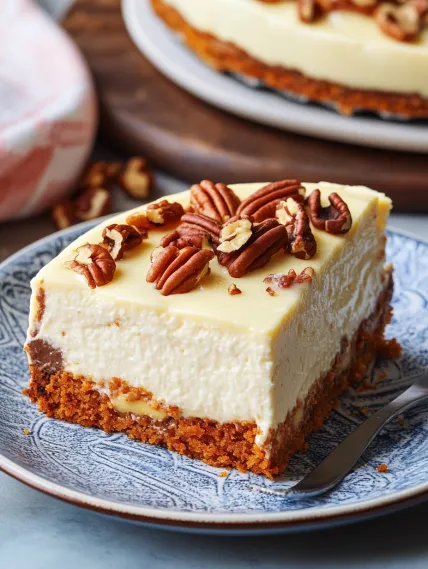 Pin
Pin
This ingenious carrot cake cheesecake brilliantly combines two beloved desserts into one showstopping creation that satisfies multiple cravings at once. A moist, spiced carrot cake base provides the perfect foundation for a silky, rich cheesecake layer that's reminiscent of the cream cheese frosting carrot cake lovers crave. The contrasting textures and complementary flavors create a harmonious dessert experience that's greater than the sum of its parts. Perfect for Easter celebrations or anytime you want to impress guests with a dessert that offers the best of both worlds, this carrot cake cheesecake is guaranteed to become a new favorite.
I first created this recipe when hosting a spring dinner party where half my guests requested carrot cake and the others wanted cheesecake. Rather than making two separate desserts, I decided to combine them – and the result was even better than either would have been on its own! What surprised me most was how perfectly the flavors complemented each other, with the tangy cheesecake enhancing the warm spices of the carrot cake below. Now, years later, this is still the most requested dessert from friends and family during spring gatherings.
Essential Ingredients and Selection Tips
- Cream Cheese: The star of the cheesecake layer. Use full-fat, brick-style cream cheese at room temperature for the smoothest result.
- Carrots: Freshly grated carrots provide moisture and natural sweetness. Grate them yourself rather than using pre-shredded for best texture and flavor.
- Canola Oil: Creates a moister carrot cake than butter would. Its neutral flavor lets the spices shine.
- Pecans: Add wonderful texture and nutty flavor. Toasting them first intensifies their flavor significantly.
- Cinnamon: The signature spice in carrot cake. Use fresh, aromatic cinnamon for the best flavor impact.
The key to this recipe's success lies in the careful balance between cake and cheesecake. I've found that using equal amounts of each batter creates the perfect ratio where neither component overpowers the other. When I tried making it with more carrot cake than cheesecake, the dessert lost its luxurious creaminess that makes it so special.
Detailed Cooking Instructions
- Step 1: Create The Perfect Carrot Cake Base
- In a large bowl, whisk together 1 cup granulated sugar, ⅓ cup canola oil, and 2 large eggs until well combined. In a separate bowl, whisk 1 cup all-purpose flour with ¾ teaspoon baking powder, ½ teaspoon baking soda, ½ teaspoon ground cinnamon, and ¼ teaspoon kosher salt. Combine the wet and dry ingredients, then fold in 1 cup finely grated fresh carrots and ¾ cup toasted chopped pecans until just incorporated.
- Step 2: Par-Bake For Structural Integrity
- Pour the carrot cake batter into a lightly greased 9-inch springform pan, spreading into an even layer. Bake at 350°F until the edges are just set and the top loses its shine, about 18 minutes. This partial baking ensures the cake layer can support the cheesecake while still remaining moist. Allow to cool for 30 minutes while preparing the cheesecake layer.
- Step 3: Craft A Silky Smooth Cheesecake Mixture
- Reduce oven temperature to 325°F. Beat 16 ounces room-temperature cream cheese until completely smooth, about 2 minutes. Gradually add ½ cup sour cream, ½ cup granulated sugar, 1 tablespoon flour, and ¼ teaspoon kosher salt, beating until smooth and creamy. Add 2 room-temperature eggs one at a time, mixing just until incorporated after each addition. Stir in 2 teaspoons vanilla extract.
- Step 4: Combine The Two Components With Care
- Starting at the outer edges of the pan, slowly and carefully pour the cheesecake batter over the partially baked carrot cake. Work your way toward the center, pouring gently to avoid disturbing the cake layer beneath. This technique prevents the cake from rising into the cheesecake layer and maintains distinct layers in the final dessert.
- Step 5: Bake And Cool With Patience
- Place the springform pan on a rimmed baking sheet and bake at 325°F until the edges are set but the center still jiggles slightly when gently shaken, 50-55 minutes. Cool completely on a wire rack for about 2 hours, then cover and refrigerate for at least 8 hours or overnight. This long chilling period is crucial for developing flavor and achieving the perfect texture.

The first time I made this dessert, I rushed the cooling process and ended up with cracks in my cheesecake layer. Now I know that patience is key – allowing the cake to cool gradually at room temperature before refrigerating prevents those unsightly cracks and results in the most velvety texture.
The Secret To Perfect Texture
The success of this dessert lies in achieving distinct yet complementary textures in each layer. Through much experimentation, I've discovered a few crucial techniques. First, finely grating the carrots ensures they blend seamlessly into the cake without creating pockets of moisture. Second, par-baking the carrot cake layer is non-negotiable – it creates a stable base that remains moist while supporting the cheesecake above. Finally, adding a small amount of flour to the cheesecake mixture helps prevent it from becoming too dense or wet where it meets the cake layer. My neighbor attempted this recipe but skipped the flour in the cheesecake, resulting in a texture that was too soft and didn't slice cleanly. These small details make a significant difference in the final result.

Make-Ahead Magic
One of the aspects I love most about this carrot cake cheesecake is how perfectly it fits into entertaining schedules. Not only can it be made ahead, but it actually improves with time in the refrigerator as the flavors meld and develop. I typically make it two days before serving, which eliminates last-minute dessert stress and results in the best flavor profile. For longer storage, you can freeze the entire cheesecake (or individual slices) for up to a month. Simply thaw overnight in the refrigerator before serving. I often make two at once during spring baking sessions, serving one for an immediate gathering and freezing the second for unexpected guests or when I need a dessert without any preparation time.
Beautiful Presentation Ideas
While this dessert is stunning in its simplicity, I've developed several presentation variations for different occasions. For Easter gatherings, I arrange pecan halves around the perimeter of the cake and place a small nest of toasted coconut in the center with a few candy eggs for a festive touch. For more elegant dinner parties, I create a border of thinly sliced candied carrots that curl decoratively around the edge. When serving for casual family dessert, I sometimes add a drizzle of caramel sauce to each plate along with a small dollop of freshly whipped cream. During fall, adding a light dusting of cinnamon or pumpkin pie spice to the top creates a seasonal variation that bridges the gap between summer and autumn desserts.
Troubleshooting Common Issues
Having made this cheesecake dozens of times, I've encountered and solved several potential problems. If your cheesecake develops cracks, you likely baked it too long or cooled it too quickly – next time, turn off the oven and let the cake cool inside with the door cracked for about 30 minutes before removing. If your carrot cake layer rises into the cheesecake during baking, you either didn't par-bake it long enough or poured the cheesecake batter too forcefully – remember to pour slowly, starting from the edges. If the texture of your cake layer seems dry, you may have overbaked it initially or measured the flour too heavily – try using the spoon-and-level method for measuring flour rather than scooping directly with the measuring cup. These simple adjustments can make the difference between a good carrot cake cheesecake and a spectacular one.

This carrot cake cheesecake has become my signature dessert, the one guests request by name and friends have been known to hint for as their birthday treat. What began as a compromise between two dessert camps has evolved into something better than either original. There's something magical about the way the spiced cake and creamy cheesecake complement each other, creating a dessert that's sophisticated yet familiar, impressive yet comforting. It's the perfect ending to any spring meal, but especially fitting for Easter when carrot desserts take center stage.
Recipe FAQs
- → Can I make this carrot cake cheesecake ahead of time?
- Absolutely! This dessert actually needs at least 8 hours in the refrigerator to set properly, making it perfect for preparing in advance. You can bake it up to three days before serving - simply let it cool completely after baking, then cover tightly with plastic wrap and refrigerate. Add the pecan decoration just before serving for the freshest presentation.
- → Why does the recipe use oil instead of butter for the carrot cake layer?
- Oil produces a moister, more tender carrot cake than butter. While butter adds flavor, it can cause cakes to bake up firmer and potentially drier. The oil in this recipe ensures the carrot cake layer stays moist and tender, even after being par-baked and then baked again with the cheesecake layer on top.
- → How do I know when the cheesecake is done baking?
- The cheesecake is done when the edges are set but the center still has a slight jiggle when you gently shake the pan. The center should not be completely firm - it will continue to set as it cools. If you bake until the center is fully set, the cheesecake will be overdone and might crack or become dry.
- → Why do I need to pour the cheesecake batter starting from the edges?
- Pouring the cheesecake batter slowly and evenly, starting from the outer edges and working toward the center, helps prevent the partially baked carrot cake from sinking in the middle. If you pour all the batter in the center, its weight could cause the cake to collapse and create an uneven dessert.
- → Can I freeze this carrot cake cheesecake?
- Yes, this cheesecake freezes beautifully! After it has completely chilled in the refrigerator, remove the sides of the springform pan and place the cake (still on the pan bottom) on a cardboard round. Wrap it tightly in plastic wrap, then in aluminum foil, and freeze for up to 1 month. Thaw overnight in the refrigerator before serving.
- → What if I don't have a stand mixer?
- While a stand mixer makes the process easier, you can use a hand mixer instead. For the cheesecake layer, make sure your cream cheese is fully softened to room temperature to avoid lumps. Beat thoroughly at each step, scraping down the sides of the bowl frequently. The key is to achieve a smooth cheesecake batter without overbeating once the eggs are added.
